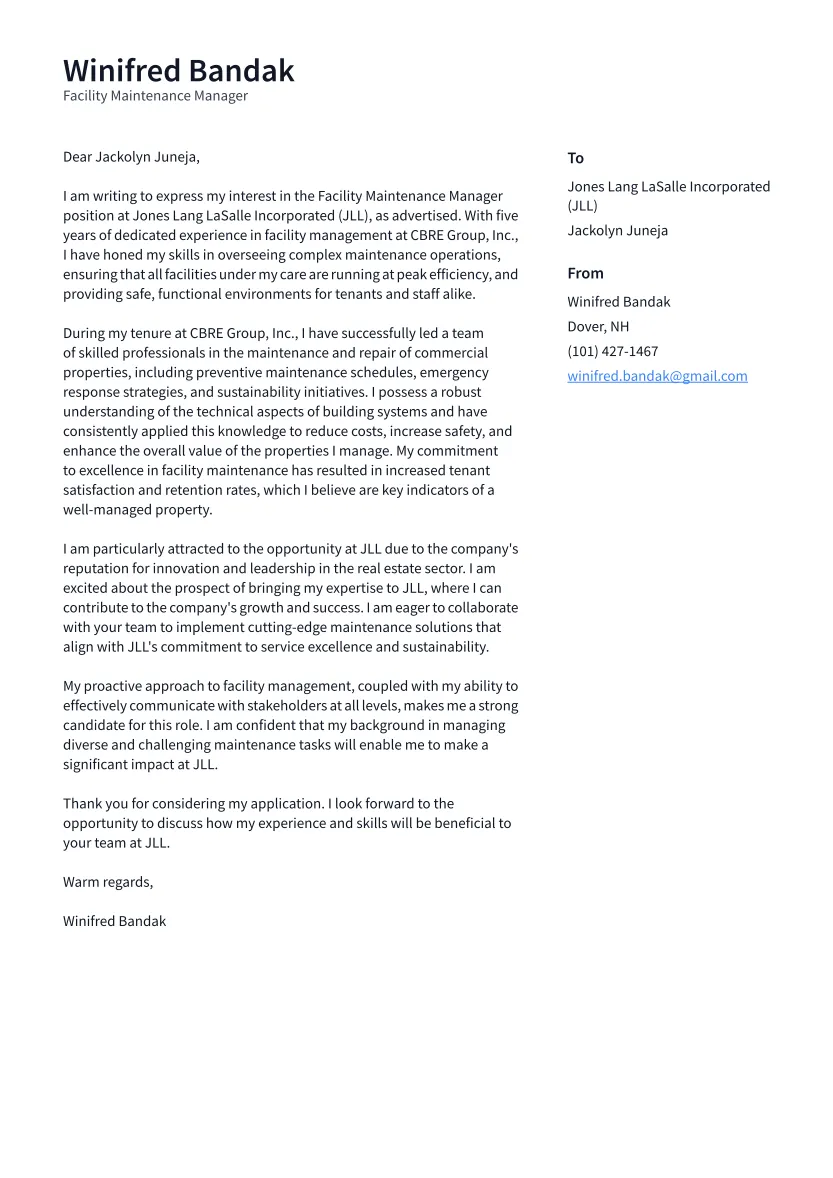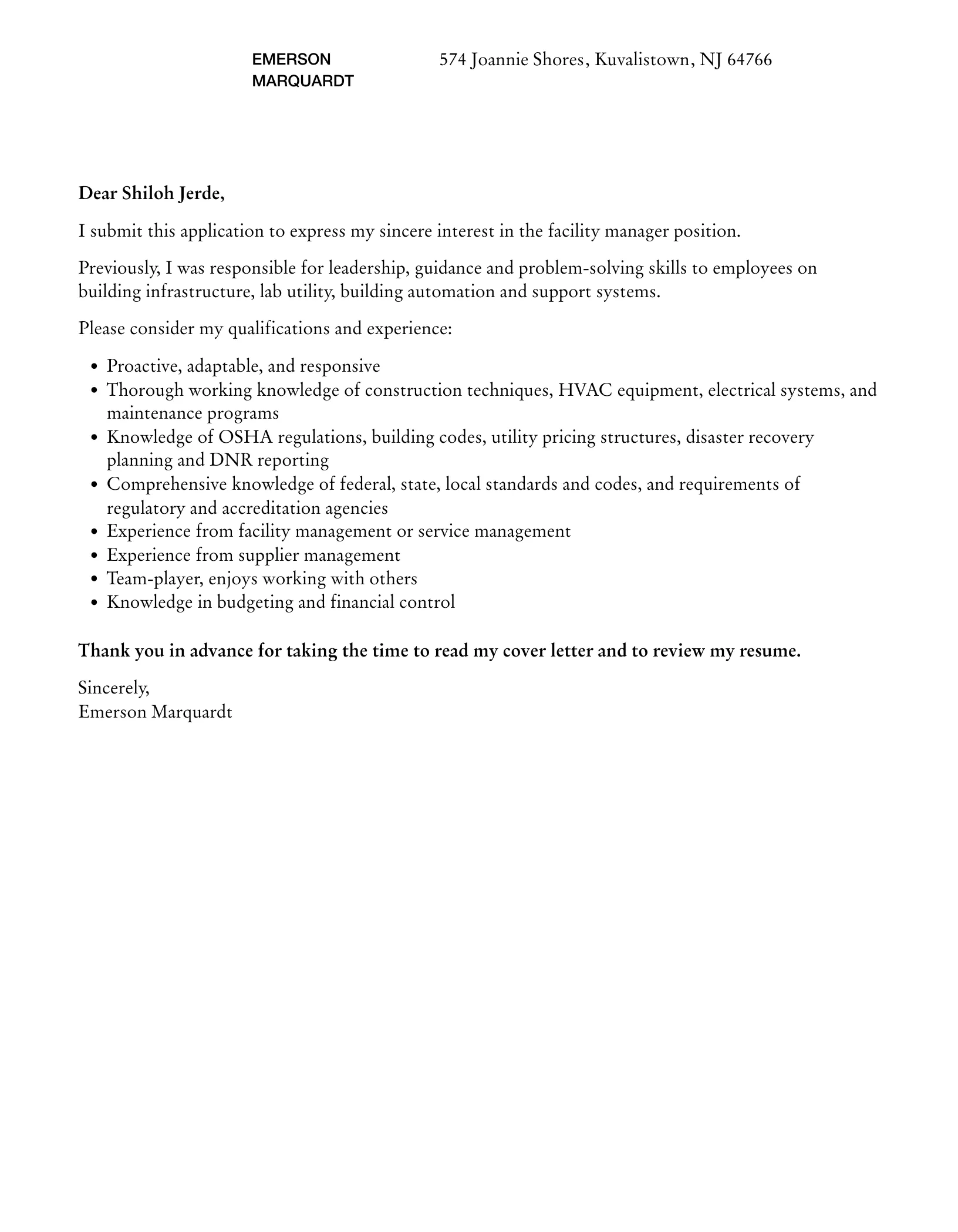Highlighting Relevant Skills and Experience
Your facility manager cover letter is your first impression. It’s an opportunity to showcase your abilities and experiences, which is why it’s important to make it stand out from the crowd. Think of your cover letter as a spotlight, highlighting the most relevant aspects of your professional history. Begin by carefully reviewing the job description to understand the specific skills and qualifications the employer is seeking. Then, strategically select the experiences and skills that align with those requirements. Don’t just list your past roles; instead, emphasize the responsibilities and accomplishments that demonstrate your capabilities. For example, if the job description emphasizes project management, highlight instances where you successfully led projects, managed budgets, and met deadlines. Similarly, if the position requires strong technical skills, provide concrete examples of your proficiency in relevant software, equipment, or maintenance procedures. Use clear and concise language to explain your contributions and quantify your achievements whenever possible. This ensures the hiring manager can quickly understand the value you bring to the table.
Quantifying Achievements
Quantifying your achievements is a key element in a successful facility manager cover letter. Numbers and data speak volumes, providing concrete evidence of your capabilities. Instead of merely stating you improved efficiency, explain by how much. Use specific metrics to showcase the impact of your work. For instance, “Reduced operational costs by 15% through implementing energy-efficient upgrades.” Or, “Successfully managed a budget of $X, resulting in projects completed on time and under budget.” Quantifying your accomplishments makes them more credible and helps the hiring manager understand your value. Consider using percentages, dollar amounts, or other measurable data to illustrate your impact. Did you reduce downtime, improve safety ratings, or increase tenant satisfaction? Provide the figures to prove it. This approach not only strengthens your cover letter but also differentiates you from other candidates who may only offer generic descriptions of their abilities. By providing tangible evidence of your past successes, you make a compelling case for why you are the right person for the job.
Using Action Verbs

A compelling cover letter utilizes strong action verbs to create a dynamic and engaging narrative. Action verbs bring your accomplishments to life, showcasing your proactive approach and ability to take initiative. Instead of saying you “were responsible for,” try using verbs like “managed,” “implemented,” “oversaw,” “developed,” or “coordinated.” Each action verb should be chosen carefully to accurately reflect your role and the impact of your work. For example, instead of “Handled maintenance requests,” you could write “Coordinated maintenance efforts, resolving an average of X requests per week, ensuring minimal downtime.” Using action verbs allows you to highlight your skills, and demonstrates your ability to make things happen. Review the job description and identify keywords to incorporate into your letter. When describing your achievements, start each sentence with a strong action verb, followed by a clear explanation of what you accomplished. This approach not only makes your cover letter more engaging but also demonstrates your understanding of the facility management role and your proactive approach to problem-solving.
Tailoring the Letter
Tailoring your cover letter to each specific job application is essential for demonstrating your genuine interest and suitability for the role. Generic cover letters often lack the specific details that hiring managers look for, making it difficult to stand out. Before you start writing, carefully analyze the job description. Identify the key requirements, responsibilities, and preferred qualifications. Then, align your cover letter with these elements. Use the job description’s language to describe your skills and experiences. Highlight the accomplishments and qualifications that directly relate to the position. This shows that you’ve taken the time to understand the employer’s needs. Mention the company’s name and briefly discuss what interests you about the organization. This can be a specific project, their mission, or their reputation. Demonstrate your knowledge of their industry and any relevant achievements that demonstrate how you can contribute. By tailoring your cover letter, you make it clear that you are not just sending a generic application but are genuinely interested in the specific opportunity. This increases your chances of getting noticed and moving forward in the hiring process.
Demonstrating Enthusiasm
Demonstrating enthusiasm in your cover letter is crucial for making a positive impression. Enthusiasm conveys your passion for the role and your eagerness to contribute. Avoid a tone that’s overly formal or generic. Instead, show genuine excitement about the opportunity. Express your interest in the company and the specific position. Mention something that caught your attention about the job description or the organization. Highlight the aspects of the role that excite you the most. For example, if the role involves sustainability initiatives, express your enthusiasm for the opportunity to contribute to a greener environment. Use positive and energetic language to describe your skills, experiences, and achievements. Instead of saying “I am qualified,” state “I am excited to bring my skills to this role.” Show how your experience aligns with the company’s goals and values. End your letter with a strong closing statement that reiterates your enthusiasm and your eagerness to discuss the opportunity further. By demonstrating your enthusiasm, you signal that you are not just looking for a job, but that you are genuinely interested in contributing to the company’s success. This personal touch can significantly increase your chances of making a memorable impression.
Formatting and Structure

Contact Information and Salutation
Proper formatting and structure are essential for creating a professional and readable cover letter. Begin by including your contact information at the top of the letter. This should include your name, phone number, email address, and LinkedIn profile (optional). Next, include the date and the hiring manager’s name and title, if available. If you don’t know the hiring manager’s name, use a general salutation like “Dear Hiring Manager.” Avoid generic greetings like “To Whom It May Concern.” Keep the formatting consistent throughout the document. Use a professional font like Arial, Times New Roman, or Calibri, and maintain a font size between 10 and 12 points. Ensure your letter is well-organized, with clear sections and headings. Use bullet points to highlight key skills and achievements, making it easy for the reader to scan the document. A well-formatted cover letter is easy to read and shows your attention to detail, which are important qualities for a facility manager.
Body Paragraphs and Content
The body paragraphs are the meat of your cover letter, where you present your skills, experiences, and qualifications. Begin with a brief introduction, stating the position you are applying for and how you learned about it. The second paragraph should highlight your relevant skills and experience, demonstrating how they align with the job requirements. Use action verbs to showcase your achievements, and provide specific examples to support your claims. The third paragraph should focus on your interest in the company and the role. Mention any research you’ve done on the organization and explain why you are interested in working there. Explain what you can bring to the company. The last paragraph should include a call to action, expressing your interest in an interview. Thank the hiring manager for their time and consideration, and reiterate your enthusiasm for the opportunity. Keep your paragraphs concise and focused, ensuring they are easy to read. Use clear and concise language throughout, avoiding jargon or overly complex sentences.
Closing and Call to Action

The closing paragraph of your cover letter should leave a strong final impression. Start by reiterating your interest in the position and your enthusiasm for the opportunity. Summarize your key skills and experiences, emphasizing how they align with the job requirements. Include a clear call to action, indicating your desire for an interview. State that you look forward to discussing your qualifications further. Thank the hiring manager for their time and consideration. Use a professional closing such as “Sincerely,” “Best regards,” or “Thank you.” Then, include your name and signature (if submitting a physical copy). Be sure to proofread your closing paragraph carefully, ensuring there are no grammatical errors or typos. The closing paragraph should be concise, confident, and leave the hiring manager with a positive impression of your qualifications and eagerness to move forward in the hiring process. A well-crafted closing can significantly increase your chances of securing an interview.
Proofreading and Editing
Checking for Errors
Proofreading and editing are the final steps in crafting a successful cover letter. A cover letter filled with errors can undermine your credibility and decrease your chances of getting an interview. Carefully check for any grammatical errors, spelling mistakes, and punctuation issues. Use spell-check and grammar-check tools to help identify errors, but don’t rely on them entirely. Review your letter multiple times, reading slowly and paying close attention to each word and sentence. Look for inconsistencies in formatting, such as incorrect font sizes or spacing issues. Ensure that all dates, names, and contact information are accurate. Pay attention to the tone of your letter, making sure it is professional and appropriate for the position. Read your cover letter out loud to hear how it sounds. This can help you catch awkward phrasing or unclear sentences. It’s also helpful to have someone else review your cover letter. A fresh pair of eyes can catch errors that you might have missed.
Ensuring Clarity and Conciseness

Clarity and conciseness are essential for an effective cover letter. Hiring managers are busy, so it’s important to make your points clearly and efficiently. Use concise language, avoiding unnecessary words or phrases. Each sentence should convey a clear and focused message. Avoid jargon or technical terms that the hiring manager might not understand. Ensure that your sentences are well-structured and easy to follow. Break up long paragraphs into shorter ones to improve readability. Make sure that your ideas flow logically, with a clear progression from one point to the next. Remove any unnecessary information that doesn’t directly relate to the job requirements. The cover letter should quickly and clearly convey your qualifications and your interest in the position. By focusing on clarity and conciseness, you can make a strong impression and demonstrate your ability to communicate effectively, a crucial skill for a facility manager.
Seeking Feedback
Seeking feedback from others is a valuable step in the cover letter writing process. Having someone else review your letter can help you identify areas for improvement and catch any errors you might have missed. Ask a trusted friend, family member, career counselor, or mentor to read your cover letter. Request specific feedback on the clarity, conciseness, grammar, and overall effectiveness of your letter. Ask them if your qualifications and enthusiasm are clearly conveyed. Encourage them to provide constructive criticism, and be open to their suggestions. Consider asking someone with experience in human resources or facility management to review your letter. They can provide valuable insights into what hiring managers look for in a cover letter. Make sure to incorporate the feedback you receive, and revise your cover letter accordingly. Getting a second opinion can significantly improve the quality of your cover letter and increase your chances of success in your job search. Remember to always proofread and edit your cover letter one last time after receiving feedback to ensure accuracy and clarity.
